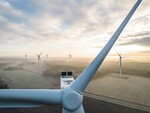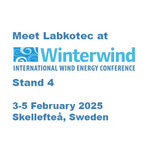04/14/2011
WWW.Windfair.Net - Special Online Editorial - A short look at Ocean Power I
Ocean Energy (OE) involves the generation of electricity from the waves, the tides, the currents, the salinity gradient, and the thermal gradient of the sea or the ocean. The ocean is an enormous and predictable source of renewable energy with the potential to satisfy an important percentage of the worldwide electricity supply. The oceans cover 75% of the world surface and, therefore, it represents one of the largest renewable energy source available to contribute to the security of energy supply and reduce greenhouse gases emissions, while enhancing the competitiveness of European industries when ocean energy conversion devices reach commercial stage.
HISTORICAL RESUME:
The possible use of marine currents as an energy resource began to draw attention in the mid-1970s after the first ‘‘oil crisis’’. In 1974 several conceptual designs were presented at the MacArthur Workshop on Energy, and in 1976 the British General Electric Co. undertook a study partially government-founded which concluded that Marine Current Power deserved more detailed research. Soon after, the ITD-Group in UK implemented a research program involving a year performance testing of a 3-m hydroDarrieus rotor deployed at Juba on the Nile. The 1980s saw a number of small research projects to evaluate Marine Current Power systems. The main countries where studies were carried out were the UK, Canada, and Japan.
In 1992–1993 the Tidal Stream Energy Review identified specific sites in UK waters with suitable current speed to generate up to 58 TWh/year. It confirmed a total Marine Current Power resource capable theoretically of meeting some 19% of the UK electricity demand. In 1994–1995 the EU-JOULE CENEX project involved a resource-assessment compilation of a database of European locations in which over 100 sites ranging from 2 to 200 km2 of sea-bed area were identified, many with power densities above 10 MW/km2.
A 2006 report from United States Department of the Interior estimates that capturing just 1/1,000th of the available energy from the Gulf Stream, which has 21,000 times more energy than Niagara Falls in a flow of water that is 50 times the total flow of all the world’s freshwater rivers, would supply Florida with 35% of its electrical needs.
POTENTIAL FUTURE OF OCEAN ENERGY:
Globally, the theoretical potential of OE has been estimated by the International Energy Agency's Implementing Agreement on Ocean Energy (IEA-OES) between 20.000 and 90 000 TWh/year (as a reference, the world’s electricity consumption is around 16.000 TWh/year). This breaks up depending on technology, in the following way:
- tide and marine current resources represent estimated annual global potentials exceeding 300 TWh and 800 TWh per annum
- Wave energy has an estimated theoretical potential of between 8,000 TWh and 80,000 TWh per annum.
- The theoretical potential of ocean thermal gradient (also known as OTEC) is estimated around 10,000 TWh per annum.
- The potential of salinity gradients is estimated at 2,000 TWh per annum.
WHY IS ELECTRICITY GENERATED FROM OCEAN CURRENTS SO APPEALLING?
The kinetic energy of marine currents can be converted in much the same way that a wind turbine extracts energy from the wind, using various types of open-flow rotors. The potential of electric power generation from marine tidal currents is enormous. There are several factors that make electricity generation from marine currents very appealing when compared to other renewables:
- The high load factors resulting from the fluid properties. The predictability of the resource, so that, unlike most of other renewables, the future availability of energy can be known and planned for.
- The potentially large resource that can be exploited with little environmental impact, thereby offering one of the least damaging methods for large-scale electricity generation.
- The feasibility of marine-current power installations to provide also base grid power, especially if two or more separate arrays with offset peak-flow periods are interconnected.
A SHORT OVERVIEW OF THE TECHNOLOGY:
There are several types of open-flow devices that can be used in marine-current-power applications; many of them are modern descendants of the old concept of the waterwheel or similar. However, the more technically sophisticated designs derived from wind-power rotors are the most likely to achieve enough cost-effectiveness and reliability to be practical in a massive marine-current-power future scenario.
Even though there is no generally accepted term for these open-flow hydro-turbines, some sources refer to them as water-current turbines. There are two main types of Water Current-Turbines that might be considered: axial-flow horizontal-axis propellers (with both variable-pitch or fixed-pitch), and cross-flow vertical-axis Darrieus rotors. Both rotor types may be combined with any of the three main methods for supporting Water-Current Turbines: floating moored systems, sea-bed mounted systems, and intermediate systems. Sea-bed-mounted monopile structures constitute the first-generation Marine Current Power systems. They have the advantage of using existing (and reliable) engineering know-how, but they are limited to relatively shallow waters (about 20 to 40 m depth).
PLEASE REFER TO ARTICLE "WWW.Windfair.Net Online Editorial - A short look at Ocean Power II" FOR AN OVERVIEW OF THE VARIOUS FORMS OF OCEAN ENERGY.
For more information on this article or if you would like to know more about what www.windfair.net can offer, please do not hesitate to contact Trevor Sievert at ts@windfair.net
www.windfair.net is the largest international B2B Internet platform – ultimately designed for connecting wind energy enthusiasts and companies across the globe!
HISTORICAL RESUME:
The possible use of marine currents as an energy resource began to draw attention in the mid-1970s after the first ‘‘oil crisis’’. In 1974 several conceptual designs were presented at the MacArthur Workshop on Energy, and in 1976 the British General Electric Co. undertook a study partially government-founded which concluded that Marine Current Power deserved more detailed research. Soon after, the ITD-Group in UK implemented a research program involving a year performance testing of a 3-m hydroDarrieus rotor deployed at Juba on the Nile. The 1980s saw a number of small research projects to evaluate Marine Current Power systems. The main countries where studies were carried out were the UK, Canada, and Japan.
In 1992–1993 the Tidal Stream Energy Review identified specific sites in UK waters with suitable current speed to generate up to 58 TWh/year. It confirmed a total Marine Current Power resource capable theoretically of meeting some 19% of the UK electricity demand. In 1994–1995 the EU-JOULE CENEX project involved a resource-assessment compilation of a database of European locations in which over 100 sites ranging from 2 to 200 km2 of sea-bed area were identified, many with power densities above 10 MW/km2.
A 2006 report from United States Department of the Interior estimates that capturing just 1/1,000th of the available energy from the Gulf Stream, which has 21,000 times more energy than Niagara Falls in a flow of water that is 50 times the total flow of all the world’s freshwater rivers, would supply Florida with 35% of its electrical needs.
POTENTIAL FUTURE OF OCEAN ENERGY:
Globally, the theoretical potential of OE has been estimated by the International Energy Agency's Implementing Agreement on Ocean Energy (IEA-OES) between 20.000 and 90 000 TWh/year (as a reference, the world’s electricity consumption is around 16.000 TWh/year). This breaks up depending on technology, in the following way:
- tide and marine current resources represent estimated annual global potentials exceeding 300 TWh and 800 TWh per annum
- Wave energy has an estimated theoretical potential of between 8,000 TWh and 80,000 TWh per annum.
- The theoretical potential of ocean thermal gradient (also known as OTEC) is estimated around 10,000 TWh per annum.
- The potential of salinity gradients is estimated at 2,000 TWh per annum.
WHY IS ELECTRICITY GENERATED FROM OCEAN CURRENTS SO APPEALLING?
The kinetic energy of marine currents can be converted in much the same way that a wind turbine extracts energy from the wind, using various types of open-flow rotors. The potential of electric power generation from marine tidal currents is enormous. There are several factors that make electricity generation from marine currents very appealing when compared to other renewables:
- The high load factors resulting from the fluid properties. The predictability of the resource, so that, unlike most of other renewables, the future availability of energy can be known and planned for.
- The potentially large resource that can be exploited with little environmental impact, thereby offering one of the least damaging methods for large-scale electricity generation.
- The feasibility of marine-current power installations to provide also base grid power, especially if two or more separate arrays with offset peak-flow periods are interconnected.
A SHORT OVERVIEW OF THE TECHNOLOGY:
There are several types of open-flow devices that can be used in marine-current-power applications; many of them are modern descendants of the old concept of the waterwheel or similar. However, the more technically sophisticated designs derived from wind-power rotors are the most likely to achieve enough cost-effectiveness and reliability to be practical in a massive marine-current-power future scenario.
Even though there is no generally accepted term for these open-flow hydro-turbines, some sources refer to them as water-current turbines. There are two main types of Water Current-Turbines that might be considered: axial-flow horizontal-axis propellers (with both variable-pitch or fixed-pitch), and cross-flow vertical-axis Darrieus rotors. Both rotor types may be combined with any of the three main methods for supporting Water-Current Turbines: floating moored systems, sea-bed mounted systems, and intermediate systems. Sea-bed-mounted monopile structures constitute the first-generation Marine Current Power systems. They have the advantage of using existing (and reliable) engineering know-how, but they are limited to relatively shallow waters (about 20 to 40 m depth).
PLEASE REFER TO ARTICLE "WWW.Windfair.Net Online Editorial - A short look at Ocean Power II" FOR AN OVERVIEW OF THE VARIOUS FORMS OF OCEAN ENERGY.
For more information on this article or if you would like to know more about what www.windfair.net can offer, please do not hesitate to contact Trevor Sievert at ts@windfair.net
www.windfair.net is the largest international B2B Internet platform – ultimately designed for connecting wind energy enthusiasts and companies across the globe!
- Source:
- Online Editorial www.windfair.net
- Author:
- Posted by Trevor Sievert, Online Editorial Journalist
- Email:
- ts@windfair.net
- Link:
- www.windfair.net/...
- Keywords:
- wind, wind energy, wind turbine, rotorblade, awea, ewea, wind power, suppliers, manufacturers; trevor sievert
- Wind Energy Wiki:
- Wave Energy

























